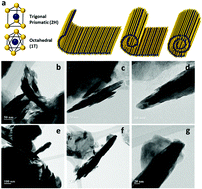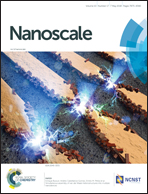A vacancy-driven phase transition in MoX2 (X: S, Se and Te) nanoscrolls†
Abstract
Atomically thin MoX2 (MoS2, MoSe2 and MoTe2) exhibits semiconducting, metallic, and semi-metallic properties associated with different polymorphic phases such as 2H, 1T and distorted 1T (1T′), respectively. The phase transitions from 2H to 1T for TMDs have been reported, but the mechanism for the formation and fraction control of 1T and 1T′ phases in phase transition processes has never been reported because the 1T and 1T′ phases are very unstable even at room temperature. To solve the problem of the thermal instability in the 1T and 1T′ phases and investigate the mechanism, we design and synthesize nanoscrolls of MoX2 which have two key attributes, bending strain for phase transition and van der Waals forces as the self-stabilizing energy for thermal stability at high temperature and then investigate the mechanism of phase transition in the synthesized nanoscrolls by an increase in temperature. It turns out that the phase transition of the 2H to the 1T phase is driven by the transition metal Mo vacancy in the XY plane and that of the 1T to the 1T′ phase is induced by the chalcogen X vacancy in the Z plane. In addition, each phase itself and fractions of the 2H, 1T and 1T′ phases in nanoscrolls can be freely controlled by inducing vacancies of transition metal and chalcogen with increasing temperature.



 Please wait while we load your content...
Please wait while we load your content...